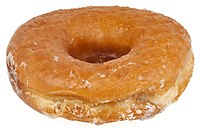
Photo from wikipedia
In this study, we designed high fiber cookie recipe without using additives by means of extrusion-based 3D printing. We aimed to relate printing quality and cookie physical properties with dough… Click to show full abstract
In this study, we designed high fiber cookie recipe without using additives by means of extrusion-based 3D printing. We aimed to relate printing quality and cookie physical properties with dough rheology and dietary fiber content depending on the flour (oat, rye, rice, and carob flour) and fat type (olive oil or butter). The flour choice influenced all cookie quality parameters: baking loss, color, line height and width, and dietary fiber content. Results indicated that lower baking loss and better printing quality were obtained for cookie dough containing olive oil, which had higher viscosity and consistency coefficient compared with dough containing butter. Cookies with olive oil in which part of the oat flour was replaced with rye and carob flour were printed with high accuracy (≥98%), close to the ideal 3D shape. Overall, this study demonstrates the importance of selecting fat and particularly flour, as well as the extrusion rate on the quality and repeatability of 3D-printed cookies.
Journal Title: Foods
Year Published: 2021
Link to full text (if available)
Share on Social Media: Sign Up to like & get
recommendations!